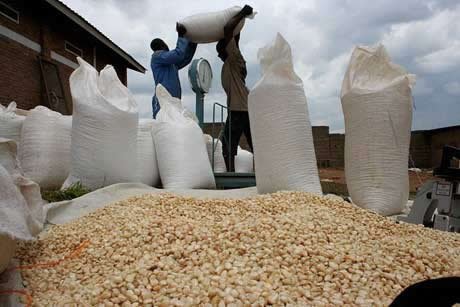From breadbasket to begging nation: How did it happen?
THE maize story in Zambia has not been as good as one would desire despite that many farmers in the country, especially at peasant level, fall on its production as a money spinner and staple food.
The recent Mast report (April 13) of farmers in parts of Central Province offloading their produce at low prices to briefcase traders is a reminder that the nation yearns for a concerted support system to produce this critical crop not only to contribute to food sufficiency but for profit to as well.
Maize, though easily grown, is beset by overhead costs such that at the end of the day a farmer may come out with nothing at all.
When rains are poor, the yield may come out bad as well. Late delivery of fertilisers has for many years affected the farmers’ harvests. Poor roads in most rural areas have held back smooth movement of the grain to market areas in the urban.
These and other factors contribute to the desperation by farmers to dispose of the crop cheaply to any body to survive. But in the next season they have bills to settle, including in some cases for borrowed fertiliser, chemicals and other in puts.
While Zambian maize farmers are hustling, neighbouring Tanzania has done so well in recent years that this country has had to import the grain from there to meet the deficit here at home.
In fact, according to the February 4, 2025 edition of the Eastleigh Voice, a Kenyan online newspaper, by 2025 Tanzania had become the second largest producer of maize in the continent after South Africa. Tanzania surpassed Nigeria which was in the second position.
Now if Tanzania can do so well in its maize production why should Zambia remain at the tail end of the ladder when, for example, the rain patterns are almost similar and the souls not so different?
Why are farmers in Tanzania motivated to grow maize to an extent that the country attains the second position as Africa’s producer of the grain? This is despite that maize production has the same overhead costs that hamper its production in Zambia.
The reason is simple. For a long time Zambia has grappled with policies in agriculture that have affected maize production.
For example, before independence colonialists set up the Grain Marketing Board (GMB) to support maize production and marketing among white settler farmers. The colonial administration then proffered massive subsidies, including seed, fertiliser, marketing and distribution while there wasn’t a single form of support to thousands of peasant farmers in rural areas.
The farmers in rural Zambia depended on barter system, that is the exchange of goods and services, to dispose of their maize. Today more than 60 years of political independence, a number of farmers in Central Province, even elsewhere in the country, are so desperate to turn to barter system not only to clear off the maize, but to survive the increasingly rugged economy.
It is the behaviour of the colonial administration that motivated first president Dr Kenneth Kaunda, to step into the maize production and disposal.
First, the pro-white Grain Marketing Board was scrapped. In its place, the National Agricultural Marketing Board (NAMBOARD) was set up to take over the functions of the former. Unlike the GMB that only supported white farmers, NAMBOARD was nationalistic. It was serving every farmer in Zambia.
Kaunda went further to establish the cooperative movement whose structures spread from primary to national. Through provincial and district cooperatives massive employment was created, above all not only to promote maize production and disposal but support was rendered to the production of other crops.
UNIP provided subsidies, including cheaper fertiliser, grain bags collection and distribution. Kaunda set up a grain bags production company, Kabwe Industrial Fabrics, which produced grain bags from jute. The idea was to make available the sacks to farmers on time. The sacks were distributed through cooperative outlets. If the maize was stuck in some rural post, the government came in to rescue the farmers by sending transport, no matter how remote.
At one point farmers in Thendere, in what is called Muchinga Province today, grew so much maize that there was no better means to bring the produce to the market. As usual the farmers threatened to sell the maize to Malawi and Tanzania. KK could not take it. He ordered the Zambia Air Force to send military helicopters to move the produce.
In short, Zambia’s agriculture policies that emerged after the removal of Kaunda have not been of much help to the country’s agricultural pursuits. Many people today blame the initial destruction of agriculture on second president Frederick Chiluba.
They argue that, for example, the scrapping of cooperatives was an emotional move that has not helped the country. Chiluba, it has been established, murdered the cooperative movement because he believed it was a political appendage, a UNIP institution whose employees in future could vote against him.
Peasant farming has never suffered the degrees it did under Chiluba than any other time since independence. Though under third President Levy Mwanawasa and his successor, Rupiah Banda, there was a glimmer of hope to boost maize production and agriculture as a whole, the situation has not improved much.
Zambia, which in the past enjoyed maize bumper harvests, exported surplus to neighbouring countries, and at one time supplied to the World Food Programme, a United Nations unit which mops up relief food for the hungry in distressed global regions, has been relegated into a beggar of maize.
The reason is simply that agricultural policies have not been consistent. Each government that comes in dreams up their own initiatives instead of improving on what others left. The political administrations that came after UNIP have made things even worse.
The support systems are flawed and most of them riddled in corruption and other aspects of maladministration. For instance, while the agricultural season is well known, every year farmers are always complaining about late delivery of fertilisers and seed. Why? In some cases fertiliser does not only get delivered late, but a wrong type or brand would be given to farmers.
In the last two years, instead of receiving six bags of fertiliser as was the case in the past, many small-scale farmers have had the indignity of sharing a bag in five litre containers or buckets called medas.
Over the years political promises to improve agriculture in Zambia have been loud, but without results. Only good workable policies to support agriculture will help curb desperation among farmers. Only then will they stop selling their hard-earned grain cheaply to briefcase dealers.
Hicks Sikazwe, is the author of Zambia’s Fall back Presidents, Wasted Years and Voters in Shadows. He is a former Deputy Editor in Chief of Times of Zambia now Communications and Media Affairs Advocate based in Ndola. Comments 0955/0966929611 or hpsikazwe@gmail.com
























